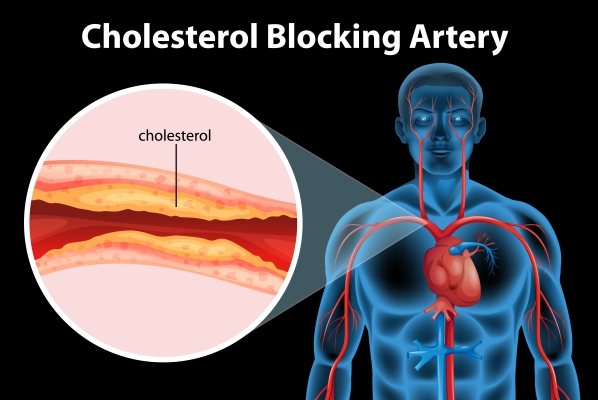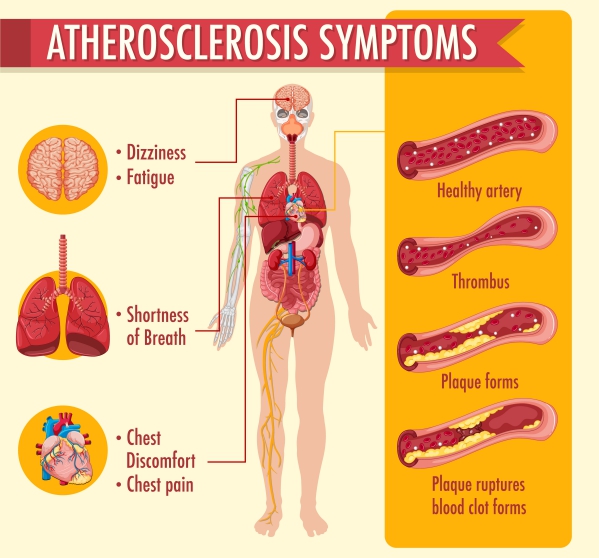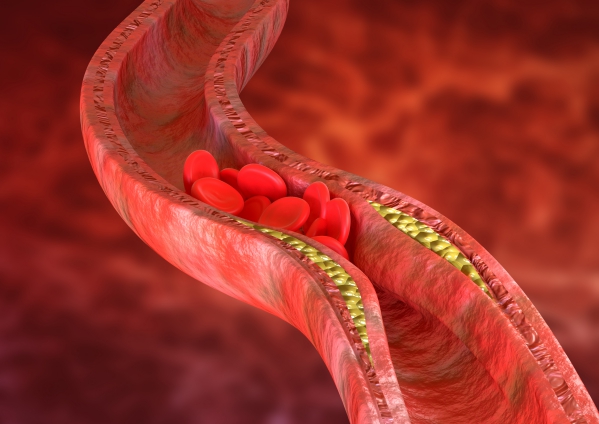What is atherosclerosis?
Atherosclerosis, also known as arteriosclerosis, is a common condition which involves the build-up of fatty deposits also known as “plaques” on the inner walls of arteries in the body. This can result in various complications as arteries are the blood vessels that carry blood that contains oxygen from the heart towards other organs and tissues. Atherosclerotic plaques tend to grow bigger with time until the whole lumen of the artery is obstructed, resulting in a blockage in the flow of blood throughout the body. This is the reason why people end up with heart attacks and strokes.
Despite the various advances in the medical field, atherosclerosis remains the main cause of death in both developed and developing countries. In the United States, it accounts for 1 in every 6 deaths, causing the death of more than 400,000 people each year.

What are the causes and risk factors of atherosclerosis?
The exact cause of atherosclerosis is not known. However, it is a gradually progressive disease that may begin at any age. It may begin when the inner layer of an artery had been injured or damaged. When this happens, inflammatory chemicals and cells are recruited at the site of injury and fat deposits start to form. In some cases, blood clots can even form on the fatty deposits. With time, the fatty plaques may rupture along with the clot, travelling further in the body until it lodges in a smaller artery causing symptoms.

The following factors may increase your risk of having atherosclerosis:
- Having a high cholesterol or triglyceride level in the blood
- Having an elevated blood pressure
- Being diabetic, especially having an uncontrolled blood sugar level
- Being a smoker
- Eating unhealthy foods
- Being overweight
- Not exercising enough
- Having a parent who had the same condition before the age of 50
How is atherosclerosis classified?
Atherosclerosis can affect any artery in the body. The name will depend on the artery affected. These include:
- Carotid artery disease: This is when the disease affects the carotid arteries, which are the arteries responsible for carrying blood from the heart to the brain. If these arteries are affected, stroke may occur.
- Coronary artery disease: This is also known as coronary heart disease. It is when atherosclerotic plaques form in the coronary arteries which are responsible to supply the walls of the heart (muscles) with oxygen rich blood. When coronary artery disease is present, it can result in a heart attack.
- Renal artery stenosis: When fatty deposits form plaques in the renal arteries, which are responsible for supplying the kidneys with blood, high blood pressure or kidney disease may arise.
- Peripheral artery disease: This is a form of atherosclerosis that affects peripheral arteries which are those that supply blood to the arms and legs. This can lead to a variety of symptoms including pain, tingling, or numbness.

What are the symptoms of atherosclerosis?
The symptoms of atherosclerosis arise due to a decrease in blood flow, especially, blood which is rich in oxygen, to target organs and tissues. The clinical presentation will depend on the location of the obstruction.
In carotid artery disease, the symptoms may include:
- Weakness
- Sudden paralysis or numb sensation in the face or limbs, usually on only one side of the body
- Confusion
- Difficulties in breathing
- Dizziness
- Headache which can be of a sudden onset and severe
- Trouble speaking and understanding
- Visual disturbances
- Loss of balance when walking
In coronary artery disease, the symptoms may include:
- Chest pain
- Discomfort in the chest
- Pain or discomfort spreading to the arms, shoulder or jaw
- Difficulties in breathing
- Chest tightness
- Nausea
- Palpitations
- Rapid heartbeat
- Choking feeling
In renal artery stenosis, the signs and symptoms may include:
- Elevated blood pressure (hypertension)
- Edema (swelling) of the extremities especially at the ankles and feet
- Decreased kidney function
- Changes in urinary frequency
- Presence of protein in the urine
- Drowsiness
- Tiredness
- Weight loss
- Vomiting
In peripheral artery disease, the symptoms may include the following:

- Numbness or weakness in the lower extremities
- Loss of hair on the legs and feet
- Brittle toenails
- Open sores or ulcers on the lower limbs that are difficult to heal
- Legs turning pale or blue
- Shiny skin of the lower extremities
- Difficulty to have an erection in males
- Shrinking of the legs due to wasting of muscles

How is the diagnosis of atherosclerosis made?
To make the diagnosis of atherosclerosis, your doctor will first take a thorough history from you to know more about your symptoms. He/she will proceed with a physical examination to look for other signs of atherosclerosis such as a weak pulse or abnormal sounds known as bruit over your arteries which is detected using a stethoscope.
Depending on your history and examination, other tests may be requested including:
- Blood tests: This includes cholesterol and blood sugar levels as if these values are elevated, you are at increased risk of having atherosclerosis. To perform the test, samples of your blood is taken and sent to a laboratory for analysis.
- Ankle-brachial index: This test helps to determine whether atherosclerosis is present in the legs. The blood pressure of your ankle is compared to the blood pressure in your arm.
- Electrocardiogram (ECG): This test is used to record the electrical activity of the heart. In this procedure, probes are placed on your chest and the electrical signals are recorded by a monitor. This can reveal if you are having or already had a heart attack.
- Doppler ultrasound: This procedure uses sound waves emitted by a special probe to visualise your arteries and blood flow. This enables the identification of any obstruction.
- Stress test: This test, also known as exercise stress test, is a procedure that allows record of your heart’s activity during physical activity. During this procedure, you will be required to walk on a treadmill or riding a stationary bike while attached to monitors.
- Angiogram or cardiac catheterization: In this procedure, a dye is injected into your arteries through a catheter. X-ray images are taken and the dye outlines the blood vessels where it travels. This allows clear identification of narrowed points in arteries.

How is atherosclerosis managed?
The first step in managing atherosclerosis involves lifestyle changes including:
- Smoking cessation: It is recommended to stop smoking as the components of cigarette smoke can damage the walls of arteries making you more prone to the progression of the condition.
- Exercise: Regular exercise can help in the development of new blood vessels that can help bypass obstructions in existing arteries. It is advised to exercise at least 30 mins per day.
- Eat healthy foods: Eat a lot of vegetables and fruits. Decreased the amount of refined carbohydrates, sugars, saturated fat and sodium. Substitute white bread with brown bread.
- Lose weight or maintain a healthy weight: If you are overweight or obese you should lose weight aiming the healthy weight range appropriate for you.
- Manage stress: Learn stress management and relaxation techniques including muscle relaxation and breathing exercises.

In some cases, medications may be prescribed including:
- Cholesterol lowering agents: These medications work by lowering the bad cholesterol known as low-density lipoprotein (LDL) and prevent the build-up of fatty deposits. These medications include statins and fibrates.
- Antiplatelet medications: Aspirin is an example of antiplatelet which works by preventing clotting of blood in arteries.
- Angiotensin-converting enzyme (ACE) inhibitors: These medications work by lowering blood pressure hence slowing the progression of atherosclerosis.
- Beta blocker medications: These drugs work by lowering the heart rate and pressure of blood as well as relieving the symptoms of chest pain.
- Calcium channel blockers: Similarly, these medications work by lowering the pressure of blood in arteries.
- Water pills (diuretics): By removing excess water from the body, water pills are effective in lowering the blood pressure in arteries.
Surgical procedures may also be carried out for the treatment of atherosclerosis. The choice of surgery will depend on the site, extent and severity of the disease. These include:

- Stent placement or angioplasty: A catheter is inserted in your blocked or narrowed artery. Another catheter is inserted through the first one through the narrowed area. This catheter contains a deflated balloon on its tip. The balloon is then inflated against the fatty deposits on the artery wall, hence widening the narrowed artery.
- Endarterectomy: In this procedure, the fatty deposits are surgically removed from the artery. It is often done when fatty deposits are present in the carotid arteries and this procedure is known as carotid endarterectomy.
- Fibrinolytic therapy: This is a procedure in which clot-dissolving medications are used to break blood clots that may be causing obstruction.
- Bypass surgery: In this procedure, a blood vessel is taken from another part of the body and this is used to bypass the obstruction present in another artery. In some cases, a tube made of synthetic material is used.

Source:
Zhao, X., 2021. Pathogenesis of atherosclerosis
Ladich, E., 2019. Atherosclerosis Pathology
Hafiane A. Vulnerable plaque, characteristics, detection, and potential therapies. J Cardiovasc Dev Dis. 2019 Jul 27. 6 (3)
Roger VL, Go AS, Lloyd-Jones DM, et al. Heart disease and stroke statistics--2012 update: a report from the American Heart Association. Circulation. 2012 Jan 3. 125(1):e2-e220.
J. Alastair, I. and Simon, M., 2016. Davidson’s Essentials of Medicine. 2nd ed. London: ELSEVIER.
Parveen, K. and Michael, C., 2017. Kumar & Clarks Clinical Medicine. 9th ed. The Netherlands: ELSEVIER.




